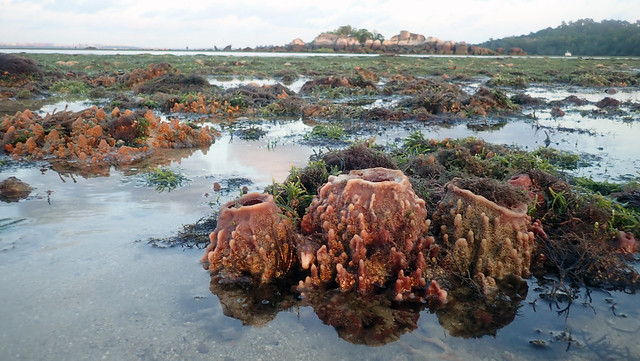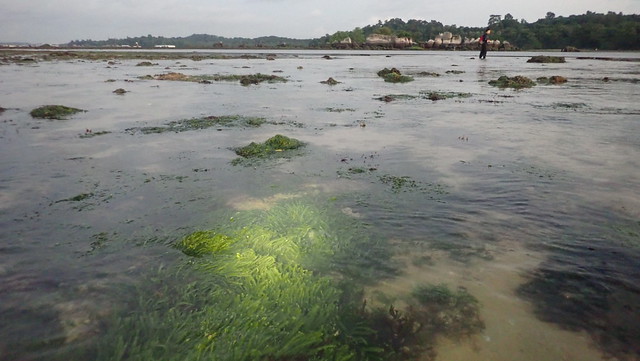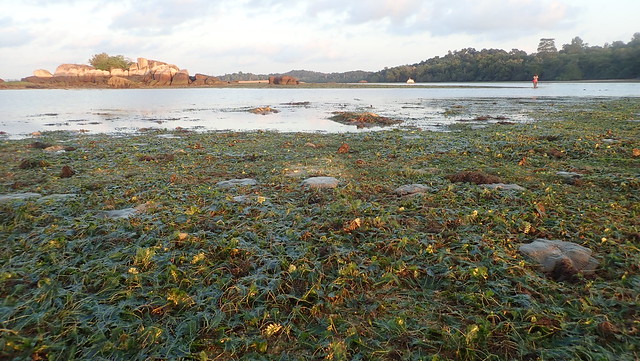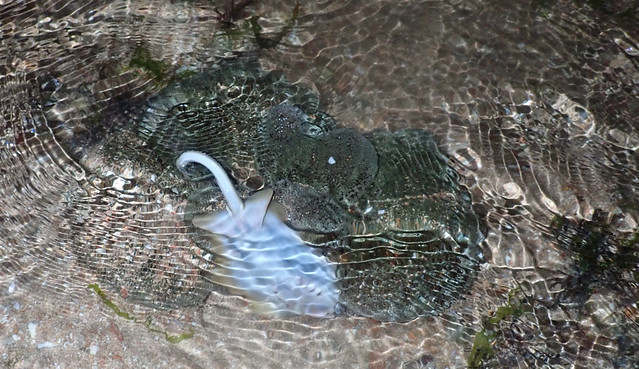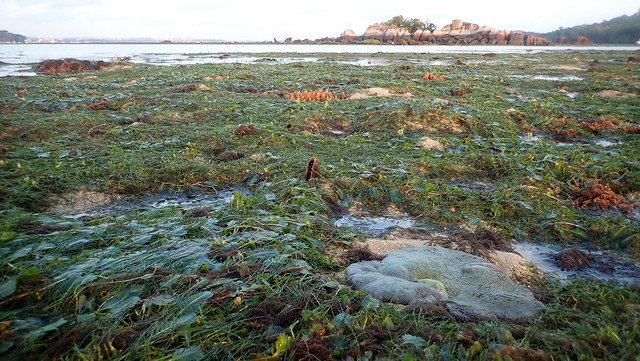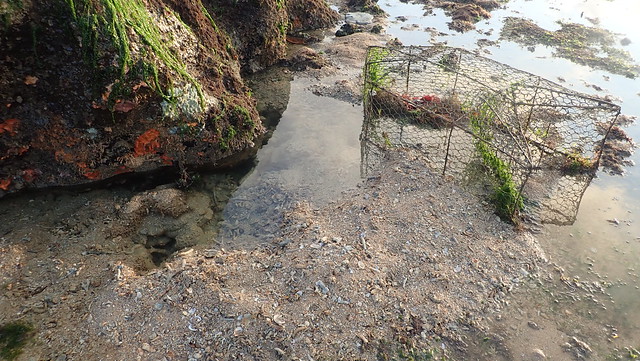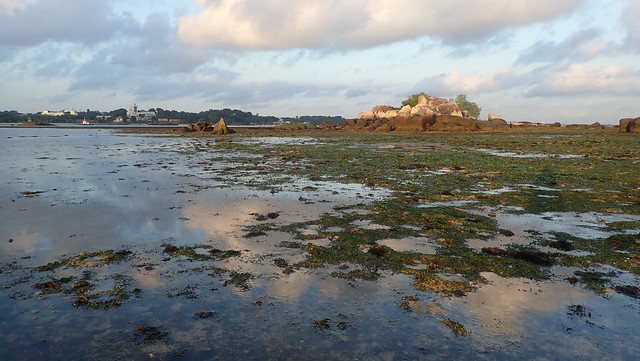But there are still sponges, and the seagrass meadows remain lush with the longest Tape seagrass I've seen in a long while. And the team found all kinds of interesting animals.
Here's a brief video of some of the interesting animals I found on Pulau Sekudu today.
At low spring tide, a lagoon on eastern side of Pulau Sekudu is revealed, surrounded by an arm of rubbly area.
The lagoon and reefy arm around it is no longer very bare and sandy as we saw in Jul 2015. During our last survey in Jun 2018, the area and the lagoon was already thickly covered with seaweeds of various kinds. But at least the outer most rubbly areas were free of seaweeds and a variety of sponges and some sea fans grew there. Today, even the outermost edges were covered with thick growth of Green feathery seaweed (Caulerpa taxifolia).
Here's a closer look at the seaweed. Some rubbly areas were covered by other kinds of seaweeds.
The western side of Pulau Sekudu had a bloom of Ulva seaweed.
Nevertheless, there are still many sponges on Pulau Sekudu. The most common sponge was Yellow bumpy sponges, which also dominated the shores at Beting Bronok and Chek Jawa on our surveys a few days earlier. There were also some nice clumps of well formed Barrel sponges. Towards the eastern tip of Sekudu's outermost shores, there were still a greater variety of sponges.
There were also many small clumps of Pink flowery soft coral and Spiky flowery soft corals growing on the rubble, not as many as I saw on Chek Jawa yesterday though. I saw many Ball flowery soft coral, some were large.
Similar to what I saw in Jun 2018, I came across a few sea fans of various kinds although most of them were heavily laden by the bloom of Ulva and other seaweeds. And some had lost a lot of tissue, leaving only bare 'wires'. I sense we saw more sea fans in better condition during our last survey in Jun 2017. Today I also saw some cerianthids and sea pens.
The highlight of Pulau Sekudu are its many Knobbly sea stars. Although I only saw a few, the rest of the team saw many (more than 20). They looked like big old grandmothers, and were rather dispersed. We didn't see any small ones. I saw several medium-sized Biscuit sea stars, There were a lot of small Garlic bread sea cucumbers (I saw the same in Jun 2018). But just a sprinkling of the usually more common Thorny and Pink warty sea cucumbers. There were also some White sea urchins and many Sponge synaptid sea cucumbers near the big rocks.
While I saw a variety of small hard coral colonies in Jun 2018, today I only saw a few small Boulder pore corals. The seagrasses are now growing lushly among the hard corals. Kok Sheng saw a small Disk coral (it seemed to be bleaching), and another bigger one that was alright. He also saw one Pock-marked coral.
Some parts of the big rocks remain coated in colourful animals such as sponges and ascidians. But we could not find the two Diadema sea urchins that used to see here for many years.
These colourful animals are eaten by others like cowries, flatworms and nudibranchs. I only saw egg ribbons of the nudibranchs, but the rest of the team saw awesome nudibranchs.
Haddon's carpet anemones remain super abundant everywhere on the shore. There were also some Swimming anemones, but much fewer Posy anemones.
The most interesting critter encounter this morning was when a small ray slammed into a carpet anemone near me. I thought the ray would just wiggle out, but was surprised that it stopped struggling after just a few minutes, and the anemone started to envelope it.
There was another carpet anemone with a large catfish on it. These anemones are indeed formidable predators!
The seagrasses are lush. The seagrasses were mostly Spoon seagrass (both small and large leaf blades). There were many patches of Fern seagrass and Needle seagrass. Kok Sheng saw a dugong feeding trail.
I saw only one clump of Tape seagrass. It had leaves that were at least 1m long, the longest I've seen in recent years. Kelvin saw another patch with shorter leaves. The patch of Serrated ribbon seagrass seems similar to what I saw in Jun 2018, growing about 10m from the low water mark.
I saw one abandoned fish trap near the big rock, which oddly has a deeply excavated area near the rock.
Juria also observed two more fish traps in the middle of the lagoon.
This little island lies just off Chek Jawa on Pulau Ubin. It is part of the Chek Jawa Wetlands that is managed by NParks.
Pulau Sekudu is off limits since 2007 and requires special permission from NParks. Thanks to NParks for permission and support to do these predawn low spring tide surveys of Chek Jawa. Thanks also to Chay Hoon for making all the transport arrangements. And the team for helping to cover as much ground as we can during the narrow low tide window. Thank you!
What is the fate of Pulau Sekudu?
Chek Jawa and Pulau Sekudu may be affected by the 2030 landuse plan by the Ministry of National Development. The plan includes plans for a road link (black line) from the mainland jumping off at Punggol, crossing to Pulau Ubin through Chek Jawa to jump off to Pulau Tekong before circling back to the mainland on Changi East. Proposed reclamation (in yellow) will bury Pasir Ris shores, Pulau Sekudu and Chek Jawa as well as a large amount of shore at Changi Beach. I feel it is thus important to update our understanding of what is going on in the field at these sites including Chek Jawa and Pulau Sekudu.
The Singapore Blue Plan 2018
Among the Proposed Areas for Immediate Conservation Priority, the Singapore Blue Plan 2018 proposes that the intertidal and subtidal marine areas of Pulau Ubin to be designated Marine Reserve.
The proposed area would include Tanjung Chek Jawa, the largest known intertidal area in northern Singapore. Considered one of the richest in Singapore, Chek Jawa comprises many adjacent ecosystems: coastal hill forest, mangrove areas, rocky shores, seagrass meadows, coral communities, and sandy areas. Chek Jawa remains an icon of celebration and hope for many Singaporeans since its reprieve from reclamation in 2001.
DOWNLOAD the Plan, SUPPORT the Plan! More on the Singapore Blue Plan 2018 site.
Posts by others on this trip
Sumita Thiagarajan
Marcus Ng
Jianlin Liu
Loh Kok Sheng
Chay Hoon
Joleen Chan
Russel Low
Kelvin Yong
Rene Ong
Juria Toramae

